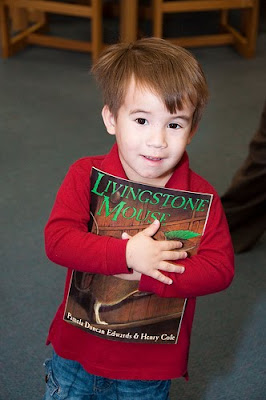Kindergarten teacher, Maria
Mallon, has started working on her Masters Degree. She allowed me to read an assigned paper connecting her own remembrances of learning to read with the research on reading at that time. Maria remembered her teacher having three reading groups - Mary, Jesus and St. Joseph (Catholic School, of course - in my first grade it was the red birds, blue birds and black birds - or buzzards as we sometimes called them!) and how the reading group she was in had shaped her vision of herself as a reader. Her writing connected me with a story from my own past of vividly remembering the day in first grade that I did not know the word "see" and called the word "look". My teacher was furious, furious, furious (as I remember it!) and pulled me up out of my chair by my ear. I was so afraid that she was going to make me wear the baby cap (which was a baby blue crocheted cap with a satin bow she made the "bad" boys wear to lunch) that I was practically trembling. Of course, I had a second grade teacher that changed my life and is the reason I went into teaching - thank goodness! Maria and I decided that if any student was ever going to track us down or write about us, we wanted it to be about something amazing that we had done to change their lives! As teachers, don't we always simply want to make a difference?

This week I finished the inspiring story of
Cindi Rigsbee, a former North Carolina Teacher of the Year (and fellow
TLNer!), and her first grade teacher, Mrs.
Warnecke, who had a positive impact on Cindi's life. Cindi began first grade with an emotionally abusive teacher who had teacher "pets." However, two months into the year half the class was moved to a basement room without windows with a beginning teacher. That beginning teacher, Mrs.
Warnecke changed Cindi's life as she made her magical classroom come alive. Cindi was introduced to writing and poetry which became lifelong passions. Cindi eventually became a teacher and tried to track down Mrs.
Warnecke because as
the years went by she realized more and more how much Mrs.
Warnecke had changed the direction of her life. She finally realized that it wasn't Mrs.
Warnecke she was trying to track down but it was the Mrs.
Warnecke within herself that she was trying to become.
In the Fall of 2008 Cindi and Mrs,
Warnecke were reunited on a tearful segment of
Good Morning, America. This book chronicles Cindi's life beginning with that life changing year with Mrs.
Warnecke to Cindi's decision to become a teacher and her
disastrous first few years teaching, to the outstanding teacher she has become. The book is also sprinkled with other teacher's stories of teachers that made a difference in their lives. This is a must read for every teacher!







.jpg)
.jpg)
.jpg)
.jpg)

































 The book above is an example of a child that has incorporated the vocabulary that the class has been learning into her writing. She has written a pattern book called, "What makes you thrilled?" This book clearly shows that she understands the word!
The book above is an example of a child that has incorporated the vocabulary that the class has been learning into her writing. She has written a pattern book called, "What makes you thrilled?" This book clearly shows that she understands the word!
 The activity above shows four of the words from the story, Mop Top, illustrated by a kindergartner - stumbled, floppy, soaring, thrilled. This activity has been used as an activity so students could show their understanding of the words but also could be used as an assessment.
The activity above shows four of the words from the story, Mop Top, illustrated by a kindergartner - stumbled, floppy, soaring, thrilled. This activity has been used as an activity so students could show their understanding of the words but also could be used as an assessment.